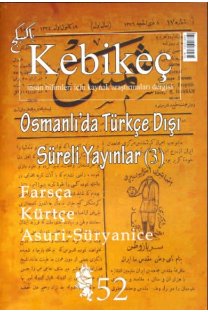İskender goçe'nin istintâknâmesi: Pindus Dağları'nda bir eşkıyânın izini sürerken
Makale, Dîvan-ı Harb-i Örfîsi tarafından 31 Aralık 1886 (4 Rebîül-âhir 1304 Hicrî) tarihinde hazırlanan şaki İskender Goçenin istintâknâmesini merkeze alarak Balkanlarda bir Osmanlı taşra vilâyeti olan Yanyadaki asayiş meselesini incelemektedir. Makalenin amacı, mikro tarihçiliğin sınırları dikkate alınarak, İskender Goçenin sorgu memurlarına verdiği yanıtlar çerçevesinde, eşkıyalık müessesesinin nasıl işlediği, bir şakinin yerel halk ve devlet görevlileriyle olan ilişkileri ve devletin eşkıyâya nasıl baktığını anlamaktır. Bunun yanı sıra, merkezi politikaların vilâyetteki asayiş sorunlarının kronikleşmesindeki payı ele alınmaktadır. Vilâyet dahilindeki jandarma birliklerinde yaşanan firarlar da bu açıdan analiz edilmiştir.
The istintaknâme of iskender goçe: Chasing down a brigand around the pindus mountains
This article examines the issue of public security in Ioannina, an Ottoman province in the Balkans, by focusing on the interrogation of a bandit called İskender Goçe on order by Ioannina Court Martial on 31 December 1886. The task of this paper is to analyse how the institution of banditry worked, the relations between the local community and also government officials and the way the state perceived the issue of banditry. By taking the limits of micro history into account, the study puts forward an analysis based on İskender Goçes responses to interrogation officers. Moreover, the role of the central policies in protracting the security problems in the region is also argued. Defections from the gendarmerie forces within the province were also evaluated from this perspective.
___
Başbakanlık Osmanlı Arşivi, BOAİrade Dahîliye (BOA, İ.DH.), 1049/82386 (15/Z/1304).
Mühimme Odası (BOA, DH.MKT.MHM.), 482/58 (10/R/1295).
Dahîliye Mektubî (BOA, DH.MKT.), 952-2 (25/S/1323).
Askerî Mârûzât (BOA, Y.PRK.ASK.), 103/61 (01/N/1312).
Siyâsî Kısım (HR.SYS.), 155-43 (26/Ca/1326).
Kitaplar ve Makaleler
Adanır, Fikret, Tradition and Rural Change in Southeastern Europe during Ottoman Rule, Daniel Chirot (ed.), The Origins of Backwardness in Eastern Europe: economics and politics from the Middle Ages until the early twentieth century, University of California Press, 1989,
Ailianos, Konstantinos I., H Austrooungaria kai i prosartisi tis Thessalias kai tis Hpeirou (1878- 1881) [Avusturya-Macaristan ve Teselya ve Epirin İlhakı (1878-1881)], İdryma Meleton Chersonisou tou Aimou, Thessaloníki, 1988.
Arapogloy, Mihalis I., Oikistiki geografia tis Ipeiroy [Epir Bölgesinde Coğrafi Olarak Yerleşim Biçimleri], Tehniko Epimelitirio Ellados-Tmima Ipeiroy, Ioannina, 2005.
Arapogloy, Mihalis I., O horos kai o anthropos [Mekân ve İnsan], Basilis G. Nitsiakos, M. Arapogloy, K. Karanatsis, Nomos Ioanninon: syghroni politismiki geografia, Nomarhiaki Aytodioikisi Ioanninon, Ioannina, 1998.
Blok, Anton, The Peasant and the Brigand: Social Banditry Reconsidered, Comparative Studies in Society and History, Vol.14, No. 4 (Sep., 1972), s. 494-503.
Cassia, Paul Sant, Myth, and Terror in Cyprus and Other Mediterranean Societies, Comparative Studies in Society and History, Vol. 35, No. 4 (Oct., 1993), s. 773-795.
Gounaris, Basil C., Peasants, Brigands and Navies: railway dreams and realities in the Ottoman Empire, The Journal of European Economic History, 34 (2005), s. 215-43.
Hobsbawm, Eric, Primitive Rebels: Studies in Archaic Forms of Social Movement in the 19th and 20th centuries, Manchester University Press, UK, 1959, 1963, 1971.
Kokolakis, Mihalis, To Ystero Gianniotiko Pasaliki: horos, dioikisi kai plithysmos stin Toyrkokratoymeni Ipeiro (1820-1913) [Geç Dönem Yanya Paşalığı: Osmanlı Devri Epir Bölgesinde Mekân, İdare ve Nüfus (1820-1913)], Kentro Neoellinikon Ereynon, E.I.E., Athina, 2003.
Koliopoulos, John S., Brigandage and Irredentism in Nineteenth-Century Greece, European History Quarterly, 19 (1989), s. 67-102;
Koliopoulos, John S., H lhsteia sthn Ellada (19os ai.) [Yunanistanda Eşkıyâlık (19. yüzyıl)], Parathrhtis, Thessalonikh, 1996.
Nikolaidou, Eleutherias I., «H organosi tou Kratous stin apeleutheromene Epeiro (1913- 1914)» [Epir Bölgesinin Kurtuluşu Sonrası Devlet Organizasyonu (1913-1914)], Dodone, t.16 A, s. 497-610.
Nikolaidou, Eleutherias I. «Apopeires Epoikismou tis Epeirou me Mousoulmanikous Plithysmous (teli 19ou ai.)» [Epir Bölgesine Müslüman Nüfus İskân Etme Teşebbüsleri (19. yüzyıl sonları)], Dodone, t. IZ, t.1, Ioannina, 1988, s. 119-133.
Nikolaidou, Eleutherias I. «Dioikitikoi kai dikastikoi Thesmoi sto Berati epi Tourkokratorias» [Osmanlı İdaresindeki Beratta İdarî ve Adlî Kurumlar], Dodone, t.11, s. 364-384.
Özbek, Nadir, Policing the Countryside: Gendarmes of the Late 19th-Century Ottoman Empire (18761908), Journal of Middle East Studies, 40 (2008), s. 47-67.
Ploymidis, Georgios S., O Ellinismos tis Ipeiroy stis paramones tis apeleytherosis toy (1905 per. -1912) [Kurtuluşunun Arefesinde Epir Bölgesinde Υunan Kültürü (1905-1912)], Dodoni, Tomos ST, Ioannina, 1977, s. 355-75.
Sourlas, Euripides, «H Epeiros epi Tourkokratias. Ek tou Archeiou tou Ypourgeiou Exoterikon Austrias» [Avusturya Dışişleri Bakanlığı Arşivlerinde Osmanlı Dönemi Epir Bölgesi], Hpeirotika Chronika, t.12, s. 133-150.
Strauss, Johan, Epirus, Dorea apo ton syngraphea, Etaireia Epeirotikon Meleton [Epir, yazar tarafından Epir Araştırmaları Merkezine hediye edilmiştir], A. 47113, Ioannina, 1994.
- ISSN: 1300-2864
- Yayın Aralığı: Yılda 2 Sayı
- Başlangıç: 1995
- Yayıncı: Mehtap Yüksel
Sayıdaki Diğer Makaleler
Tevfik Sağlam'ın iki mektubu ve bir raporu ışığında 1933 Üniversite reformu
İskender goçe'nin istintâknâmesi: Pindus Dağları'nda bir eşkıyânın izini sürerken
O ince çizgi: Osmanlı son dönemi pratiğinde eşkıyalıkla kahramanlık arasında salınanlar
Ata Çelebi ve Akın Gazetesi (1944-1946) üzerine notlar
Uluslararası oryantalistler kongreleri (1873-1973) üzerine bir değerlendirme
1950'li yıllarda Türk sineması'nın efeleri
